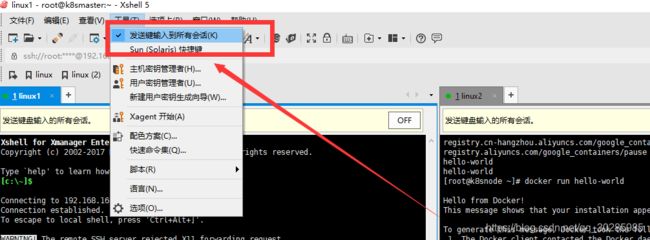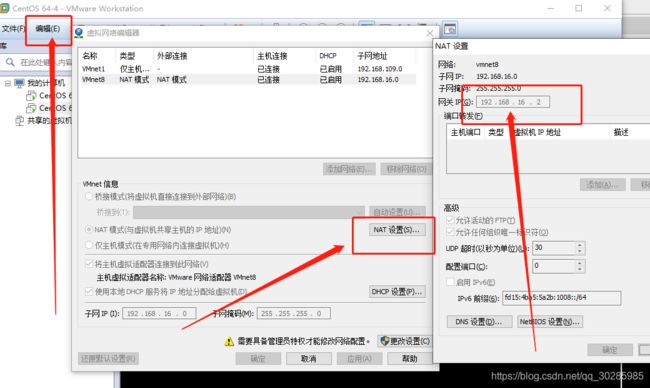【k8s】虚拟机k8s搭建教程
文章目录
- 前言
- 一、环境配置
-
-
-
- 1.系统镜像
- 2.环境要求
- 3. 静态ip配置
- 4.关闭防火墙
- 5. 关闭selinux
- 6. 关闭swap(k8s禁止虚拟内存以提高性能)
- 7. 配置host
- 8. 设置网桥参数
- 9.更新时间
-
-
- 二、docker安装
-
-
-
- 10.更新yum源
- 11.安装docker
- 12.配置开机自启
- 13.配置加速器
- 13.docker查看命令
-
-
- 四、k8s安装
-
-
-
- 14. 添加k8s的阿里云YUM源
- 15. 安装 kubeadm,kubelet 和 kubectl
- 16.开机自启
- 17.查看是否安装成功
- 18.半路总结
- 19.初始化主节点
- 20.初始化node节点
- 21.网络插件
- 22.测试
-
-
前言
对于学习k8s时,搭建环境是一个很麻烦的一步,在此,阐述下虚拟机搭建k8s,一主一从。请大家参考,如果想要虚拟机,可直接留言获取。
一、环境配置
1.系统镜像
我使用的镜像为CentOS Linux release 7.9.2009 (Core),镜像可以从官方下载,也可以留言即可找我要已经安装好的虚拟机。
[root@k8smaster ~]# cat /etc/redhat-release
CentOS Linux release 7.9.2009 (Core)
2.环境要求
- 一台或多台机器,操作系统CentOS 7
- 硬件配置:内存2GB或2G+,CPU 2核或CPU 2核+;
- 集群内各个机器之间能相互通信;
- 集群内各个机器可以访问外网,需要拉取镜像;
- 禁止swap分区;
3. 静态ip配置
本人虚拟机使用的是NAT模式,配置如下,大家参考下即可。
TYPE="Ethernet"
PROXY_METHOD="none"
BROWSER_ONLY="no"
BOOTPROTO="static"
DEFROUTE="yes"
IPV4_FAILURE_FATAL="no"
IPV6INIT="yes"
IPV6_AUTOCONF="yes"
IPV6_DEFROUTE="yes"
IPV6_FAILURE_FATAL="no"
IPV6_ADDR_GEN_MODE="stable-privacy"
NAME="ens33"
UUID="49c13795-9323-433a-af08-caacd886f189"
DEVICE="ens33"
ONBOOT="yes"
IPADDR="192.168.16.135"
NETMASK="255.255.255.0"
DNS1="192.168.16.2"
4.关闭防火墙
k8s一般是在内部网络使用,而且这也是学习环境,直接关闭防火墙,避免网络通讯的困扰。
systemctl stop firewalld
systemctl disable firewalld
5. 关闭selinux
#永久
sed -i 's/enforcing/disabled/' /etc/selinux/config
#临时
setenforce 0
6. 关闭swap(k8s禁止虚拟内存以提高性能)
#永久
sed -ri 's/.*swap.*/#&/' /etc/fstab
#临时
swapoff -a
7. 配置host
这里要根据实际情况进行配置。配置好对应的master节点和node节点。
cat >> /etc/hosts << EOF
192.168.16.135 k8smaster
192.168.16.137 k8snode
EOF
8. 设置网桥参数
cat > /etc/sysctl.d/k8s.conf << EOF
net.bridge.bridge-nf-call-ip6tables = 1
net.bridge.bridge-nf-call-iptables = 1
EOF
#生效
sysctl --system
9.更新时间
yum install ntpdate -y
ntpdate time.windows.com
二、docker安装
10.更新yum源
#可选
yum install wget -y
wget https://mirrors.aliyun.com/docker-ce/linux/centos/docker-ce.repo -O /etc/yum.repos.d/docker-ce.repo
11.安装docker
yum install docker-ce-19.03.13 -y
12.配置开机自启
systemctl enable docker.service
13.配置加速器
默认情况下,docker拉取镜像速度挺慢的,可以通过设置阿里云加速器
加速器配置
配置完成之后可以将docker重启一下。
docker重启
systemctl restart docker.service
13.docker查看命令
查看docker状态
systemctl status docker.service
查看当前已下载的镜像
docker images
拉取镜像
docker pull hello-world
运行镜像
[root@k8snode ~]# docker run hello-world
Hello from Docker!
This message shows that your installation appears to be working correctly.
To generate this message, Docker took the following steps:
1. The Docker client contacted the Docker daemon.
2. The Docker daemon pulled the "hello-world" image from the Docker Hub.
(amd64)
3. The Docker daemon created a new container from that image which runs the
executable that produces the output you are currently reading.
4. The Docker daemon streamed that output to the Docker client, which sent it
to your terminal.
To try something more ambitious, you can run an Ubuntu container with:
$ docker run -it ubuntu bash
Share images, automate workflows, and more with a free Docker ID:
https://hub.docker.com/
For more examples and ideas, visit:
https://docs.docker.com/get-started/
如此docker安装成功。
四、k8s安装
14. 添加k8s的阿里云YUM源
cat > /etc/yum.repos.d/kubernetes.repo << EOF
[kubernetes]
name=Kubernetes
baseurl=https://mirrors.aliyun.com/kubernetes/yum/repos/kubernetes-el7-x86_64
enabled=1
gpgcheck=0
repo_gpgcheck=0
gpgkey=https://mirrors.aliyun.com/kubernetes/yum/doc/yum-key.gpg https://mirrors.aliyun.com/kubernetes/yum/doc/rpm-package-key.gpg
EOF
15. 安装 kubeadm,kubelet 和 kubectl
yum install kubelet-1.19.4 kubeadm-1.19.4 kubectl-1.19.4 -y
16.开机自启
systemctl enable kubelet.service
17.查看是否安装成功
yum list installed | grep kubelet
yum list installed | grep kubeadm
yum list installed | grep kubectl
版本查看
[root@k8snode ~]# kubelet --version
Kubernetes v1.19.4
18.半路总结
如果正确安装到这里的时候,已经成功安装一大半了,如上的配置都是需要在所有的节点进行配置。可通过xshell工具将所有指令发送到所有的虚拟机,操作如下。


另外,有一些配置是需要重启才能生效的,因此,这里可以重启一下。
19.初始化主节点
kubeadm init --apiserver-advertise-address=192.168.16.135 --image-repository registry.aliyuncs.com/google_containers --kubernetes-version v1.19.4 --service-cidr=10.96.0.0/12 --pod-network-cidr=10.244.0.0/16
192.168.16.135是主节点的地址,要自行修改。其它的不用修改。
mkdir -p $HOME/.kube
sudo cp -i /etc/kubernetes/admin.conf $HOME/.kube/config
sudo chown $(id -u):$(id -g) $HOME/.kube/config
最后查看节点信息
kubectl get nodes
20.初始化node节点
kubeadm join 192.168.16.135:6443 --token a0n3bj.8o7dhcphidtid5fk \
--discovery-token-ca-cert-hash sha256:00b608e1314662953a52975c2b5c6c2f4440d2abb255434e459935ba373fa4e8
如上这段仅仅是参考,实际部署的时候这段join命令会在主节点init命令的时候进行打印。
至此通过kubectl get nodes查看的时候所有的节点是NotReady状态。
21.网络插件
将如下保存为kube-flannel.yml文件。在主节点上执行即可
kubectl apply -f kube-flannel.yml
执行完毕稍等1分钟左右,再次查看通过kubectl get nodes查看。
---
apiVersion: policy/v1beta1
kind: PodSecurityPolicy
metadata:
name: psp.flannel.unprivileged
annotations:
seccomp.security.alpha.kubernetes.io/allowedProfileNames: docker/default
seccomp.security.alpha.kubernetes.io/defaultProfileName: docker/default
apparmor.security.beta.kubernetes.io/allowedProfileNames: runtime/default
apparmor.security.beta.kubernetes.io/defaultProfileName: runtime/default
spec:
privileged: false
volumes:
- configMap
- secret
- emptyDir
- hostPath
allowedHostPaths:
- pathPrefix: "/etc/cni/net.d"
- pathPrefix: "/etc/kube-flannel"
- pathPrefix: "/run/flannel"
readOnlyRootFilesystem: false
# Users and groups
runAsUser:
rule: RunAsAny
supplementalGroups:
rule: RunAsAny
fsGroup:
rule: RunAsAny
# Privilege Escalation
allowPrivilegeEscalation: false
defaultAllowPrivilegeEscalation: false
# Capabilities
allowedCapabilities: ['NET_ADMIN', 'NET_RAW']
defaultAddCapabilities: []
requiredDropCapabilities: []
# Host namespaces
hostPID: false
hostIPC: false
hostNetwork: true
hostPorts:
- min: 0
max: 65535
# SELinux
seLinux:
# SELinux is unused in CaaSP
rule: 'RunAsAny'
---
kind: ClusterRole
apiVersion: rbac.authorization.k8s.io/v1
metadata:
name: flannel
rules:
- apiGroups: ['extensions']
resources: ['podsecuritypolicies']
verbs: ['use']
resourceNames: ['psp.flannel.unprivileged']
- apiGroups:
- ""
resources:
- pods
verbs:
- get
- apiGroups:
- ""
resources:
- nodes
verbs:
- list
- watch
- apiGroups:
- ""
resources:
- nodes/status
verbs:
- patch
---
kind: ClusterRoleBinding
apiVersion: rbac.authorization.k8s.io/v1
metadata:
name: flannel
roleRef:
apiGroup: rbac.authorization.k8s.io
kind: ClusterRole
name: flannel
subjects:
- kind: ServiceAccount
name: flannel
namespace: kube-system
---
apiVersion: v1
kind: ServiceAccount
metadata:
name: flannel
namespace: kube-system
---
kind: ConfigMap
apiVersion: v1
metadata:
name: kube-flannel-cfg
namespace: kube-system
labels:
tier: node
app: flannel
data:
cni-conf.json: |
{
"name": "cbr0",
"cniVersion": "0.3.1",
"plugins": [
{
"type": "flannel",
"delegate": {
"hairpinMode": true,
"isDefaultGateway": true
}
},
{
"type": "portmap",
"capabilities": {
"portMappings": true
}
}
]
}
net-conf.json: |
{
"Network": "10.244.0.0/16",
"Backend": {
"Type": "vxlan"
}
}
---
apiVersion: apps/v1
kind: DaemonSet
metadata:
name: kube-flannel-ds
namespace: kube-system
labels:
tier: node
app: flannel
spec:
selector:
matchLabels:
app: flannel
template:
metadata:
labels:
tier: node
app: flannel
spec:
affinity:
nodeAffinity:
requiredDuringSchedulingIgnoredDuringExecution:
nodeSelectorTerms:
- matchExpressions:
- key: kubernetes.io/os
operator: In
values:
- linux
hostNetwork: true
priorityClassName: system-node-critical
tolerations:
- operator: Exists
effect: NoSchedule
serviceAccountName: flannel
initContainers:
- name: install-cni
image: quay.io/coreos/flannel:v0.13.0
command:
- cp
args:
- -f
- /etc/kube-flannel/cni-conf.json
- /etc/cni/net.d/10-flannel.conflist
volumeMounts:
- name: cni
mountPath: /etc/cni/net.d
- name: flannel-cfg
mountPath: /etc/kube-flannel/
containers:
- name: kube-flannel
image: quay.io/coreos/flannel:v0.13.0
command:
- /opt/bin/flanneld
args:
- --ip-masq
- --kube-subnet-mgr
resources:
requests:
cpu: "100m"
memory: "50Mi"
limits:
cpu: "100m"
memory: "50Mi"
securityContext:
privileged: false
capabilities:
add: ["NET_ADMIN", "NET_RAW"]
env:
- name: POD_NAME
valueFrom:
fieldRef:
fieldPath: metadata.name
- name: POD_NAMESPACE
valueFrom:
fieldRef:
fieldPath: metadata.namespace
volumeMounts:
- name: run
mountPath: /run/flannel
- name: flannel-cfg
mountPath: /etc/kube-flannel/
volumes:
- name: run
hostPath:
path: /run/flannel
- name: cni
hostPath:
path: /etc/cni/net.d
- name: flannel-cfg
configMap:
name: kube-flannel-cfg
22.测试
k8s环境安装成功,拉取nginx镜像进行测试。
#创建deploy
kubectl create deployment nginx --image=nginx
#开放端口
kubectl expose deployment nginx --port=80 --type=NodePort
查看端口
[root@k8smaster ~]# kubectl get service
NAME TYPE CLUSTER-IP EXTERNAL-IP PORT(S) AGE
kubernetes ClusterIP 10.96.0.1 <none> 443/TCP 2d17h
nginx NodePort 10.109.58.243 <none> 80:32024/TCP 4s

